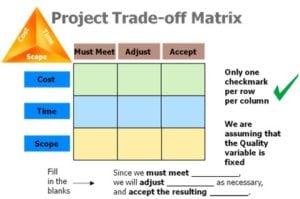
I have often talked about the triple constraints (scope, cost, and schedule) and the Fissure Quintuple constraints (adding quality and team productivity as equally important constraints or variables). Most of you are very familiar with the triple/quintuple constraint relationship and the fact that you can’t change one without impacting the others. Considering just the triple constraints, if the focus is on schedule, then cost and scope will tend to suffer. If the focus is on scope, then cost and schedule tend to suffer. If a project makes schedule focused decisions one week, sacrificing cost and scope, then makes scope focused decisions the next week, sacrificing cost and schedule, then makes cost focused decisions the third week, sacrificing scope and schedule, by the end of the project it is highly unlikely that any of the constraints will be met.
What is needed is a clear and consistent priority among the triple constraints. If there is an agreed upon priority among the three, when decisions are made during the project, they will be consistently made to meet the “must meet” (or highest priority) constraint. To do that they will need to adjust to meet the “adjust” (or secondary priority) constraint, and then accept the resulting “accept” (or third priority) constraint. The matrix below is a simple, yet powerful tool to identify the priorities and stay consistent in project decisions that impact the scope, schedule and cost.


In our simulation powered workshops we introduce the matrix to students and ask them who should set the priorities. They always give the right answer, the stakeholders, particularly the sponsor. But of course, this is also the time in the workshop where the students laugh and relate stories about how stakeholders insist that all three constraints are equal and there is no need for prioritizing. Some students actually insist there is no way to get their stakeholders to set a priority; that is sad, since it is too often true.
I have always been somewhat at a loss to explain how to deal with this roadblock. How do you convince stakeholders that they have to set a priority; that they can’t have everyone focused on everything at the same time? My best answer up to now has been to give them the triple/quintuple constraint lecture using examples of project decisions that optimize one constraint while negatively impacting one or more of the other constraints. It is easy to say, but in reality difficult to do and may need to be repeated several times, particularly after projects that had no priorities and failed to meet any of the constraints.
I recently read a book that I think can help you deal with this roadblock the next time you are trying to get your stakeholders to fill-in the trade-off matrix. The name of the book is “Plugged”, and it is written by Krissi Barr and Dan Barr. It is a very short book that is mostly told through the story of a business challenge and somewhat through the story of improving your golf game (which of course is what drew me to the book). The key learning from the book is a very sensible three step approach to success – PAR. The first step is “Prioritize”; focus on what matters most. Now you can see how I made the connection between the book and stakeholders and the trade-off matrix.
Stakeholders and PMs/BAs want a successful project and we often talk about defining what success will look like when the project is done. Defining success is a critical upfront piece, but we also need to prioritize the success criteria so everyone is not only focused on what matters most, but also focused on what is second most important, and not focused on what is least important. Setting and keeping focused on what it is most important on the project (and not changing what is most important with every situation) is critical to a successful project. We all know that if we are singularly focused and not pulled constantly in other directions we will have the best chance to meet that objective.
The second step in the Barr’s PAR approach to success is “Adapt”; see change as an opportunity. Most project change comes from the stakeholders, particularly the customers and users. The changes usually have an impact on the triple constraints, and when you add up numerous changes, they definitely have an impact on the triple constraints. So in this case the project managers and business analysts need to communicate back to the stakeholders what the impact will be on cost and schedule when additional scope is added or current scope is changed. If there is significant change, it might be time to reset the constraints and get everything back in balance. In other words, can the desired scope be delivered within the cost and schedule constraints? If it can’t, it is time to change the constraints. It is also good practice to first have a trade-off discussion concerning the change. Is the change an opportunity we can’t pass up? Is the change an opportunity that is worth the related impact of cost and schedule?
The last step in the PAR approach to success is “Be Responsible”; take ownership of the outcome. Here is another reference to “what is the project going to look like when it is done?” And more importantly, who is responsible for the outcome and making sure the objectives have been met? Stakeholders are responsible for setting the objectives and priorities for the triple constraints, and the project managers are responsible for managing to those objectives and priorities. If you have and follow a trade-off matrix you will have significantly better results in meeting constraints based on the chosen priorities.
In conclusion, if you are not currently using one, start using a trade-off matrix with your stakeholders. Have them prioritize between scope, schedule, and cost. If they resist, talk to them about the “P” in PAR. The priority is to help the team focus on what is most important. Remember, only one objective/constraint can be the most important. Help your stakeholders and team get comfortable with change on your projects and how changing one constraint impacts others. Follow your priorities as you deal with the change and accept that at some point you might have to reset the constraints to get the constraints back into a balance where you can meet them all successfully. Lastly, be clear about stakeholder and project manager outcome responsibility on the project. Both parties are responsible for project success, with the stakeholders responsible for setting priorities and focus (filling in the trade-off matrix), while the project manager is responsible for managing to those priorities (following the trade-off matrix). Go for PAR!
